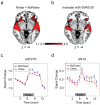Gum chewing inhibits the sensory processing and the propagation of stress-related information in a brain network
- PMID: 23573184
- PMCID: PMC3616056
- DOI: 10.1371/journal.pone.0057111
Gum chewing inhibits the sensory processing and the propagation of stress-related information in a brain network
Abstract
Stress is prevalent in human life and threatens both physical and mental health; stress coping is thus of adaptive value for individual's survival and well-being. Although there has been extensive research on how the neural and physiological systems respond to stressful stimulation, relatively little is known about how the brain dynamically copes with stress evoked by this stimulation. Here we investigated how stress is relieved by a popular coping behavior, namely, gum chewing. In an fMRI study, we used loud noise as an acute stressor and asked participants to rate their feeling of stress in gum-chewing and no-chewing conditions. The participants generally felt more stressful when hearing noise, but less so when they were simultaneously chewing gum. The bilateral superior temporal sulcus (STS) and the left anterior insula (AI) were activated by noise, and their activations showed a positive correlation with the self-reported feeling of stress. Critically, gum chewing significantly reduced the noise-induced activation in these areas. Psychophysiological interaction (PPI) analysis showed that the functional connectivity between the left AI and the dorsal anterior cingulate cortex (dACC) was increased by noise to a lesser extent when the participants were chewing gum than when not chewing gum. Dynamic causality modeling (DCM) demonstrated that gum chewing inhibited the connectivity from the STS to the left AI. These findings demonstrate that gum chewing relieves stress by attenuating the sensory processing of external stressor and by inhibiting the propagation of stress-related information in the brain stress network.
Conflict of interest statement
Figures





Similar articles
-
Mastication as a Stress-Coping Behavior.Biomed Res Int. 2015;2015:876409. doi: 10.1155/2015/876409. Epub 2015 May 18. Biomed Res Int. 2015. PMID: 26090453 Free PMC article. Review.
-
Impact of gum chewing on stress levels: online self-perception research study.Curr Med Res Opin. 2009 Jun;25(6):1491-500. doi: 10.1185/03007990902959283. Curr Med Res Opin. 2009. PMID: 19425900 Clinical Trial.
-
Effect of Gum Chewing on PFC Activity During Discomfort Sound Stimulation.Adv Exp Med Biol. 2020;1232:113-119. doi: 10.1007/978-3-030-34461-0_16. Adv Exp Med Biol. 2020. PMID: 31893402
-
Functional connectivity of human chewing: an fcMRI study.J Dent Res. 2013 Mar;92(3):272-8. doi: 10.1177/0022034512472681. Epub 2013 Jan 25. J Dent Res. 2013. PMID: 23355525 Free PMC article.
-
Stimulus-dependent activations and attention-related modulations in the auditory cortex: a meta-analysis of fMRI studies.Hear Res. 2014 Jan;307:29-41. doi: 10.1016/j.heares.2013.08.001. Epub 2013 Aug 11. Hear Res. 2014. PMID: 23938208 Review.
Cited by
-
The Neural Correlates of Chewing Gum-A Neuroimaging Review of Its Effects on Brain Activity.Brain Sci. 2025 Jun 18;15(6):657. doi: 10.3390/brainsci15060657. Brain Sci. 2025. PMID: 40563827 Free PMC article. Review.
-
Chewing gum: cognitive performance, mood, well-being, and associated physiology.Biomed Res Int. 2015;2015:654806. doi: 10.1155/2015/654806. Epub 2015 May 17. Biomed Res Int. 2015. PMID: 26075253 Free PMC article.
-
Mastication as a Stress-Coping Behavior.Biomed Res Int. 2015;2015:876409. doi: 10.1155/2015/876409. Epub 2015 May 18. Biomed Res Int. 2015. PMID: 26090453 Free PMC article. Review.
-
High masticatory ability attenuates psychosocial stress: A cross-sectional study.PLoS One. 2023 Jan 18;18(1):e0279891. doi: 10.1371/journal.pone.0279891. eCollection 2023. PLoS One. 2023. PMID: 36652405 Free PMC article.
-
Stress Reduction Effects during Block-Tapping Task of Jaw in Healthy Participants: Functional Near-Infrared Spectroscopy (fNIRS) Measurements of Prefrontal Cortex Activity.Brain Sci. 2022 Dec 14;12(12):1711. doi: 10.3390/brainsci12121711. Brain Sci. 2022. PMID: 36552170 Free PMC article.
References
-
- Viner R (1999) Putting stress in life. Soc Stud Sci 29(3): 391–410.
-
- McEwen BS (2007) Physiology and neurobiology of stress and adaptation: Central role of the brain. Physioll Rev 87(3): 873–904. - PubMed
-
- de Kloet ER, Joëls M, Holsboer F (2005) Stress and the brain: From adaptation to disease. Nat Rev Neurosci 6: 463–475. - PubMed
Publication types
MeSH terms
Substances
LinkOut - more resources
Full Text Sources
Other Literature Sources
Medical

